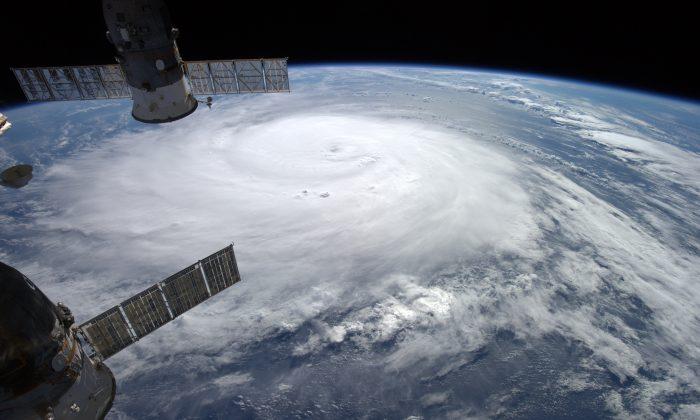HAMILTON, Bermuda—Hurricane Gonzalo crushed trees, flattened power lines and damaged Bermuda’s main hospital during an hours-long battering, but the tiny, wealthy British territory suffered no deaths.
The storm’s center crossed over Bermuda Friday night and Gonzalo quickly moved northward over the Atlantic on a track that could take it just off the shore of Newfoundland in Canada.
“This was a dangerous hurricane, but Bermuda today is dealing with property damage, blocked roads and a loss of electricity, all things that can be replaced and restored,” said Premier Michael Dunkley. “Thankfully, there has been no loss of life.”
He said the U.S., the United Kingdom and others have offered assistance.
The hospital, which suffered a damaged roof, was still operating, and bulldozers were clearing trees from roads as crews worked to restore power to some 24,000 homes.
[aolvideo src=“http://pshared.5min.com/Scripts/PlayerSeed.js?sid=1759&width=480&height=300&playList=518468845&responsive=false”]
Maria Frith, who owns Grape Bay Cottages on Bermuda’s south coast, said in a phone interview that the hurricane woke her up Saturday before dawn when it tore the patio roof off her house.
“To be perfectly honest with you, I was terrified, partly because of the noise,” she said. “It was really scary.”
Police Commissioner Michael DeSilva said many roads were impassible and urged people to stay home, warning on the island’s Emergency Broadcast Station that motorists would be turned back.
“Unless it’s a life or death emergency — checking on your boat is not an emergency — we won’t let you pass,” he said.
Gonzalo approached Bermuda as a Category 3 storm then weakened to Category 2 strength just before coming ashore with sustained winds of 110 mph (175 kph).
Some Bermudians woke up to toppled concrete walls, uprooted palm trees and boats run aground. The Royal Gazette newspaper reported that part of the roof of the island’s legislature, the House of Assembly, was ripped off.
Flooding was the main concern on Bermuda, which has one of the highest per-capita incomes in the world and is known for strict building codes meant to ensure homes can withstand sustained winds of at least 110 mph (177 kph).
The last major hurricane to strike Bermuda was Fabian in September 2003. That Category 3 storm killed four people and caused more than $100 million in damage.
The island was still recovering from last weekend’s blast from Tropical Storm Fay, which also damaged homes and toppled power lines.
“To be struck twice by two different cyclones is unusual, to say the least,” said Max Mayfield, a former director of the U.S. National Hurricane Center in Miami.
A 436-foot (133-meter) frigate of Britain’s Royal Navy with a crew of some 180 sailors was expected to arrive Sunday in Bermuda to help with post-storm recovery efforts.
The U.S. National Hurricane Center said Gonzalo weakened as it moved away from Bermuda on a track that would take it past Newfoundland and then across the Atlantic to Britain and Ireland.
Canadian Hurricane Center officials said the storm isn’t expected to be a hurricane as it nears Canadian waters, but there was 30 percent chance it would make landfall as a post-tropical storm overnight Saturday. Officials said there could be some flooding if it arrives at high tide early Sunday.
Across the Atlantic, Britain’s Met Office issued an alert for strong winds and heavy rain expected Tuesday from the remains of Gonzalo. It warned of the potential for significant disruption of travel and difficult driving conditions.
Early Saturday, Gonzalo was located 450 miles (725 kilometers) north-northeast of Bermuda with maximum sustained winds of 90 mph (150 kph) as it traveled north-northeast at 29 mph (46 kph).
The storm earlier claimed one life in the Dutch territory of St. Maarten and the hurricane center said it could still whip up dangerous surf on portions of the U.S. coast.
In the Pacific, recently formed Tropical Storm Trudy was centered over land about 75 miles (120 kilometers east-northeast of Acapulco, and it was dumping heavy rains. Maximum sustained winds were 40 mph (65 kph), the hurricane center said.
Meanwhile, Hurricane Ana was carving a path south of Hawaii, producing high waves, strong winds and heavy rains that prompted a flood advisory. The center of the storm was about 155 miles (250 kilometers) southwest of the Big Island and about 190 miles (305 kilometers) from Honolulu, the National Weather Service said.
There was little chance for hurricane conditions on the islands, but a tropical storm watch remained in effect throughout the archipelago and the strongest winds were about 80 mph (129 kph).
From The Associated Press. AP writer Rob Gillies in Toronto contributed to this report.

Friends Read Free